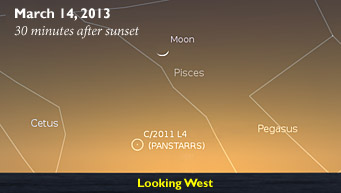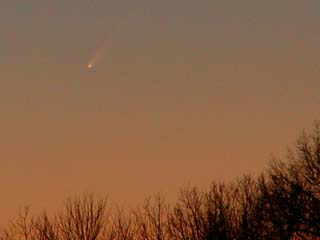The inbound comet C/2011 L4, discovered last June, has been brightening steadily the past few months. At this rate, it could become a pretty bauble in post-sunset skies next March.
The hearts of comet-watchers are beating a little faster these days. That's because Comet Pan-STARRS (C/2011 L4) continues its inward drive toward the Sun and, based on the most recent observations, remains on track for a fine showing in northern skies next March. All indications point to a peak magnitude of anywhere from +1 to -1 — bright enough to deliver the best northern-sky performance since Comet Holmes's unexpected splash in 2007.

The discovery sequence for Comet Pan-STARRS (C/2011 L4), showing the 19th-magnitude object's motion against background stars from 9:20 to 10:23 Universal Time on June 6, 2011
PS1 Science Consortium
Now, to quote all those stock-market come-ons, "Past performance is no guarantee of future results." As I mentioned last June, this interloper was only 19th magnitude when spotted by the 1.8-m robotic Panoramic Survey Telescope & Rapid Response System (Pan-STARRS) atop Haleakala in Hawaii. Here we are 10 months later, and it's barely inside Jupiter's orbit — still a whopping 5 astronomical units from the Sun and no more than a 14th-magnitude blip on the celestial radar screen.
But the comet brightened by a whole magnitude during March, exceeding expectations. From his site in Cloudcroft, New Mexico, veteran observer Alan Hale spotted it visually on March 30th with a 16-inch (41-cm) reflector. "It's small and quite condensed," he reports, "and despite its faintness is not especially difficult to see."
Based on the trend to date, both the IAU's Minor Planet Center and JPL's Horizons system predict that perihelion will occur next March 10th or 11th. By then the comet will be inside Mercury's orbit and close to magnitude 0 in brightness.
So how might that look from here? First, note that perihelion occurs on the far side of the Sun from both Mercury itself (thus no chance for Messenger to spot it) and from Earth. For much of 2012, Comet Pan-STARRS lollygags in Scorpius and Libra, then it dives a bit south at year's end before making a beeline into northern skies.

Whether it's bright or not, Comet Pan-STARRS (C/2011 L4) will be positioned low in the western evening sky a few days after it reaches perihelion next March.
Sky & Telescope diagram / source: Stellarium
Throughout all of this, those of you below the equator will have the comet to yourselves. But it should finally burst on the scene for northern skygazers about March 10th — right at perihelion — again favoring those of you at low latitudes (Costa Rica, anyone?). Unfortunately, when brightest, C/2011 L4 will appear only 15° from the Sun.
So will you be able to spot it using just your eyeballs? Opinions vary. For sure you'll need a vantage with an unobstructed view toward west. According to comet chronicler Gary Kronk, "It could be a challenge to see with the naked eye, although observations using binoculars and telescopes will certainly be possible." Long-time observer John Bortle agrees: "At the moment I don't see Comet Pan-STARRS becoming strikingly evident in the evening twilight for the great majority of observers."
Hale is more optimistic: "On March 13th — three days after perihelion — the comet will be almost due east of the Sun and, from my latitude at least, sets over an hour after sunset, around the end of civil twilight. From my experience, a comet near magnitude 0.5 that sets an hour after sunset should be pretty easy to spot naked-eye. The background sky will still be fairly bright, of course, but if there is any significant tail development, we should be able to see a few degrees of it."

Comet McNaught (C/2006 P1) was barely visible to northern skygazers in January 2007.
Roger W. Sinnott
My take is: "Let's be cautious, with fingers crossed." Perhaps we'll see something akin to how Comet McNaught (C/2006 P1) appeared as it skirted the western horizon at dusk five years ago. I could see it if I knew where to look and, more importantly, when to look — not too soon after sunset.
In any case, you can count on us to keep you up to date about Comet Pan-STARRS.
 4
4









Comments
Kevin Heider
July 17, 2012 at 12:39 pm
Comet C/2011 L4 probably took millions of years to come from the Oort cloud. After leaving the planetary region of the Solar System, the post-perihelion orbital period is estimated to be about 110000 years.
You must be logged in to post a comment.
Eduard Gutierrez
November 30, 2012 at 12:42 pm
Here! A Costarican eagerly expecting this comet and C/2012 S1 🙂
You must be logged in to post a comment.
Rolando
February 5, 2013 at 12:11 pm
I'll go to the countryside of Panama to see it on March 5. If you can post a chart to look for it in the sky of Panama I'll appreciate it.
You must be logged in to post a comment.
Azael
February 19, 2013 at 11:16 am
For C/2011 L4, after a run on Cartes du Ciel (v3.6), and for Panama (9°N 79°33'W) we should be able to see the comet since February 28th just above the horizon just after sunset, until April 4th, again just after sunset. On those day it will be just over the horizon for a few minutes. The highest reach on the horizon will be on February 13th-14th, when it will be at 13° above the horizon at 6:30pm EST and will come down to the horizon at about 7:30pm EST, giving plenty of time to view it and photograph it. Of course, here in Panama (tropics), there is always the problem of cloudiness. So we will keep a watch from March 1st to April 3rd, and photograph all days the sky is clean. We just hope the Cartes de Ciel database is OK.
You must be logged in to post a comment.
You must be logged in to post a comment.